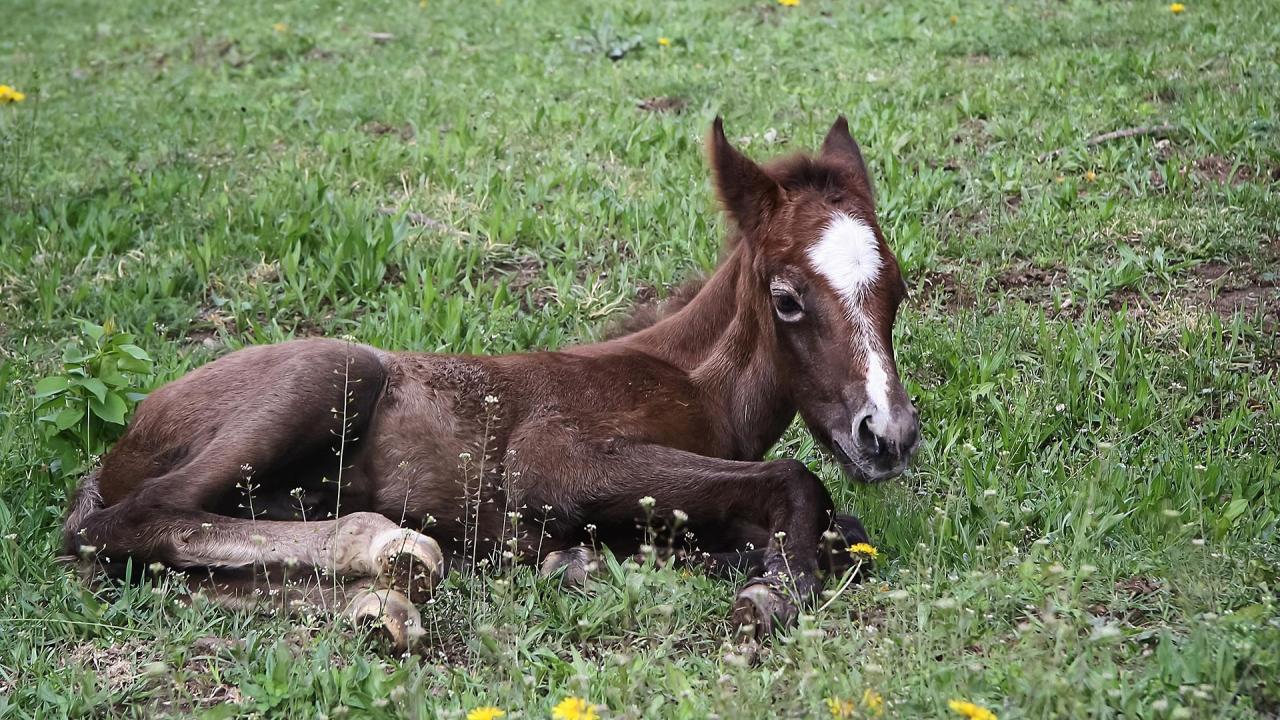
Equine Juvenile Spinocerebellar Ataxia (EJSCA)
What is equine juvenile spinocerebellar ataxia?
Takeaways
- Equine juvenile spinocerebellar ataxia (EJSCA) is an inherited fatal neurologic disease in American Quarter Horse foals.
- Affected foals exhibit incoordination, or ataxia, and clinical signs progress rapidly to severe weakness in the hind limbs and the inability to stand without assistance.
- There is no treatment for EJSCA. Affected foals are humanely euthanized.
- A validated genetic test for EJSCA is currently only available through the UC Davis Veterinary Genetics Laboratory. Breeders can use this test to avoid producing affected foals.
Equine juvenile spinocerebellar ataxia (EJSCA) is an inherited fatal neurologic disease. Affected foals exhibit clinical signs between 1 and 4 weeks of age. These signs progress rapidly from incoordination to severe hind limb weakness and the inability to stand without assistance.
Physiologically, clinical signs result from the deterioration of axons, structures that connect neurons so they can communicate via electrical pulses. Once axons begin to degrade in the spinal cord, neurons have difficulty communicating, so affected foals do not know where their legs are in relation to the ground.
To date, EJSCA has been identified in American Quarter Horse foals. Research performed at UC Davis identified an autosomal recessive mode of inheritance for this disease, meaning that an affected foal needs two copies of the identified genetic variant to become affected. Dams and sires with one copy of the EJSCA variant (i.e. carriers) are not affected, but risk passing the disease variant on to their offspring.
What are the clinical signs of equine juvenile spinocerebellar ataxia?
Clinical signs of equine juvenile spinocerebellar ataxia include an asymmetric ataxia, where one side (left or right) is often more severely affected. Additionally, the hind limbs are more severely affected than the front limbs. Affected foals often exhibit a “sideways walking” gait, where the hind legs drift to one side. The onset of clinical signs is sudden, with no known history of trauma.
How is equine juvenile spinocerebellar ataxia diagnosed?
Equine juvenile spinocerebellar ataxia is diagnosed based on clinical signs and confirmed through a validated genetic test*, currently only available through the UC Davis Veterinary Genetics Laboratory. Results for affected foals are reported as JSA/JSA.
Blood tests from affected foals often indicate elevated glucose and gamma-glutamyl transferase (GGT) levels, which are commonly associated with a variety of health issues from stress to inflammation. Blood tests on their own are insufficient for a diagnosis of EJSCA, but they can provide information to rule out other potential causes.
How is equine juvenile spinocerebellar ataxia treated?
There is no treatment for equine juvenile spinocerebellar ataxia.
What is the prognosis for equine juvenile spinocerebellar ataxia?
Foals affected with equine juvenile spinocerebellar ataxia are humanely euthanized.
How can equine juvenile spinocerebellar ataxia be prevented?
Breeders can use the UC Davis genetic test for equine juvenile spinocerebellar ataxia to avoid producing affected foals. The test is simple and requires 20-30 hairs with roots from potential parents. Results are reported as:
N/N Normal – No copies of the EJSCA variant detected
N/JSA Carrier – One copy of the allele associated with EJSCA detected
Breedings between two carriers have a 25% chance of producing an EJSCA-affected foal.
For more information
UC Davis Veterinary Genetics Laboratory - Equine Juvenile Spinocerebellar Ataxia Genetic Test
Willis, A. T., Dahlgren, A. R., Woolard, K. D., Ghosh, S., Donnelly, C. G., de la Concha-Bermejillo, A., Pacheco, A., Watson, K. D., Berryhill, E., Aleman, M., Wensley, F., Humphreys, S., Whitehead, A. E., Goldsmith, D., Chesen, B., Ragsdale, J., Tompkins, J. E., Nash, R., Plunkett, A. H., Qualls, H. J., … Finno, C. J. (2024). Clinicopathological and pedigree investigation of a novel spinocerebellar neurological disease in juvenile Quarter Horses in North America. Journal of veterinary internal medicine, 38(3), 1808–1814. doi: 10.1111/jvim.17049
American Quarter Horse Association - Equine Juvenile Spinocerebellar Ataxia
The Fence Post Breeder’s Connection 2025: Equine Juvenile Spinocerebellar Ataxia
Equus – New Genetic Disease in Horses Identified
* A scientific paper describing this gene and the genetic mutation is currently in progress. More information will be available soon.
This article may not be reproduced without the written consent of the UC Davis Center for Equine Health. Please email requests to cehadmin@ucdavis.edu.
